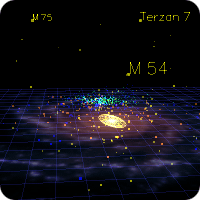Well, you're right, but I will tell you before we even get started. The 'star' of the Navigating the Cosmos event at the 2009 World Science Festival, even in such illustrious company as Tyson and the whole Universe, was a guy named Carter Emmart, and I had to look up his actual title ("Director of Astrovisualization for the Rose Center") because he was introduced in the beginning as some sort of functional tour guide but as it turned out he stole the show with this deft grasp of what turns out to be a pretty vast universe. He didn't have the coolest title - that honor went to a fellow named Brian Abbott, whose business card reads "Manager, Digital Universe" ('manager of the universe' has to make it easy to pick up women in bars, right?) but he had the coolest job - he literally navigates the cosmos for kids and adults alike.
If you aren't familiar with what Hayden Planetarium has done, here is the snapshot. They've spent just over 10 years combining all of the data from all of the telescopes out there and making a 'three-dimensional' map of the Universe. With fiber optics and high-speed data you can 'fly' through the Universe.

Looking back on the Milky Way from M54, a globular
cluster that's 85,000 light-years from Earth.
Credit: Hayden Planetarium
Obviously our data is incomplete because we are at a fixed point in space looking out in lots of directions so some of the data is inferred more than others. Outside the Milky Way, you have galaxies and quasars but can't zoom in on planets the way you can Earth or the moon - still, a sky filled with an untold number of galaxies, not just stars, you can navigate around is a thing to behold and the chance to have some 250 extrasolar planets all on one screen is mind-blowing.
Neil deGrasse Tyson, Frederick P. Rose Director of Hayden Planetarium in the Department of Astrophysics at the American Museum of Natural History, kicked things off. Tyson is quite a showman and that's part of the reason he hosts a show on PBS but he is also a New York guy through and through which is why he has the job he has. He got his Ph.D. at Columbia and his first experience seeing stars, age 9 he says, was at Hayden Planetarium. Knows his stuff? That's a given, but his engaging personality and enthusiasm for the subject draws in fans young and old.

Neil deGrasse Tyson with Bloggy at World Science Festival
Lawrence Krauss was next and, to someone like me, Krauss was the reason to attend this event. Krauss is currently Foundation Professor in the School of Earth and Space Exploration and Director of the Origins Initiative at Arizona State University, which sounds like a lot, but more importantly to most people he is the author of "The Physics of Star Trek."
Krauss is always a fun speaker. He can talk on a variety of subjects but people at this event wanted to see him talk about big cosmic things. And he did.
But, again, what stole the show was Emmart. Virtually no challenge from the presenters went unmet. Want to see Earth from Rigel? Suddenly you are flying away at dizzying speed until you are in the constellation Orion. Hayden is not your granddaddy's planetarium and Emmart knows the 3-D universe in ways few other people can.
Krauss talked about not only what we were seeing but why it mattered that we were seeing it and what limitations we still had and how we would see more in the future. Despite this not being a 'canned' presentation, I don't think they had even rehearsed what they were going to talk about, Krauss and Emmart worked smoothly together. Not only could Emmart instantly know what the presenters wanted but often offered a better perspective, anticipating what would resonate with the audience and taking a 'route' that enhanced the experience, without becoming part of the show himself.
Next I saw Evalyn Gates, Assistant Director of the Kavli Institute for Cosmological Physics at the University of Chicago and author of "Einstein’s Telescope" but her presentation was a slideshow extracted from her book. If we're going to see a slideshow on gravitational lensing I don't want to have to strain my neck doing it. Jim Gates, John S. Toll Professor of Physics at the University of Maryland-College Park and advisor to Obama, was last and I felt bad for him. He may have had the greatest presentation there but a lot of people who had gone all the way to Central Park, bought tickets, gone up an elevator in very small groups and waited in a crowded foyer cleared the room during the Evalyn Gates slideshow.
For my part, I had another event at 8 PM I wanted to catch but losing people whose primary evening was built around this is a real shame, yet it's good data for next year's event; when you have a talk on the cosmos and all the data in the world on our known Universe at your disposal, use it. That means more zipping around galaxies and less Powerpoint and even less advocacy for pet theories on dark matter.
You don't have to visit Hayden Planetarium to get part of the experience yourself, so if you want to fly around the universe on your own, sans Carter Emmart, download the data and viewer here. It won't be quite the same but it will still be pretty terrific. More World Science Festival articles can be found here.





Comments